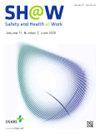Development of an Enhanced Risk Assessment Model for Human–Robot Collaboration and its Application
IF 2.9
3区 医学
Q1 PUBLIC, ENVIRONMENTAL & OCCUPATIONAL HEALTH
引用次数: 0
Abstract
Background
Collaborative robots have emerged as a solution for complex and precision-driven tasks. However, there is no comprehensive risk assessment model for collaborative robotic work in the Republic of Korea. Thus, we aim to develop a risk assessment model tailored to the unique characteristics of human-robot collaboration.
Methods
In this study, we examine the risk assessment factors in three key fields: worker, robotic systems, and work environment. The items adopted in the existing models of HFACS, USUS, and human–robot trust were initially selected to extract items for the risk assessment model. The analytic hierarchy process methodology was applied to refine and prioritize the evaluation items. Score scales were constructed for the six checklists. A five-level score ranging from one to five was given to each question in the checklist, and the average score was used to quantitatively evaluate each area.
Results
The six evaluation checklists coalesced to constitute a comprehensive risk assessment model was adjusted for collaborative robot operations. Implementing the proposed model in six robot-operated workplaces yielded consistent results. Companies involved in previous robot-related accidents exhibited deficiencies in these risks than accident-free robot workplaces. Thus, comprehensive risk assessments encompassing the necessary factors are crucial to prevent accidents in robot-related work environments.
Conclusion
The proposed risk assessment model can offer a robust foundation for guiding the future development of diverse risk assessment models for collaborative robot environments and facilitate the safe coexistence of humans and robots in the Industry 4.0 era.
一种增强的人机协作风险评估模型及其应用
协作机器人已经成为复杂和精确任务的解决方案。然而,在韩国没有针对协作机器人工作的综合风险评估模型。因此,我们的目标是开发一种适合人机协作独特特征的风险评估模型。方法研究人员、机器人系统和工作环境三个关键领域的风险评估因素。初步选取现有HFACS、USUS、人机信任模型中采用的项目,提取项目用于风险评估模型。采用层次分析法对评价项目进行细化和排序。为六个检查表构建了评分量表。对清单中的每个问题给出1到5分的5个等级的分数,并用平均分数对每个领域进行定量评价。结果将6个评估清单合并成一个综合风险评估模型,对机器人协同作业进行了调整。在六个机器人操作的工作场所实施所提出的模型产生了一致的结果。与没有发生事故的机器人工作场所相比,之前发生过机器人相关事故的公司在这些风险方面表现出了不足。因此,包含必要因素的全面风险评估对于防止机器人相关工作环境中的事故至关重要。结论所建立的风险评估模型可为指导未来协作机器人环境中多种风险评估模型的发展提供坚实的基础,促进工业4.0时代人类与机器人的安全共存。
本文章由计算机程序翻译,如有差异,请以英文原文为准。
求助全文
约1分钟内获得全文
求助全文
来源期刊

Safety and Health at Work
Social Sciences-Safety Research
CiteScore
6.40
自引率
5.70%
发文量
1080
审稿时长
38 days
期刊介绍:
Safety and Health at Work (SH@W) is an international, peer-reviewed, interdisciplinary journal published quarterly in English beginning in 2010. The journal is aimed at providing grounds for the exchange of ideas and data developed through research experience in the broad field of occupational health and safety. Articles may deal with scientific research to improve workers'' health and safety by eliminating occupational accidents and diseases, pursuing a better working life, and creating a safe and comfortable working environment. The journal focuses primarily on original articles across the whole scope of occupational health and safety, but also welcomes up-to-date review papers and short communications and commentaries on urgent issues and case studies on unique epidemiological survey, methods of accident investigation, and analysis. High priority will be given to articles on occupational epidemiology, medicine, hygiene, toxicology, nursing and health services, work safety, ergonomics, work organization, engineering of safety (mechanical, electrical, chemical, and construction), safety management and policy, and studies related to economic evaluation and its social policy and organizational aspects. Its abbreviated title is Saf Health Work.
 求助内容:
求助内容: 应助结果提醒方式:
应助结果提醒方式:


